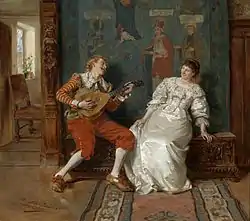Falling in love
Falling in love is the development of strong feelings of attachment and love, usually towards another person.

| Part of a series on |
| Love |
|---|
Red-outline heart icon |

The term is metaphorical, emphasising that the process, like the physical act of falling, is sudden, uncontrollable and leaves the lover in a vulnerable state, similar to "fall ill" or "fall into a trap".
It may also reflect the importance of the lower brain centers in the process,[1] which can lead the rational, accounting brain to conclude (in John Cleese's words) that "this falling in love routine is very bizarre....It borders on the occult".[2]
Factors
Mental
"Factors known to contribute strongly to falling in love include proximity, similarity, reciprocity, and physical attractiveness",[3] while at the same time, the process involves a re-activation of old childhood patterns of attachment.[4] Deep-set psychological parallels between two people may also underpin their pairing-bonding,[5] which can thus border on mere narcissistic identification".[6]
Jungians view the process of falling in love as one of projecting the anima or animus onto the other person, with all the potential for misunderstanding that can involve.[7]
Chemical

Two chemical reactions associated with falling in love are increases in oxytocin and vasopressin;[8] and Elisabeth Young-Bruehl has suggested that "when we fall in love we are falling into a stream of naturally occurring amphetamines running through the emotional centres of our very own brains".[6] With regard to sociobiology, it is stressed that mate selection cannot be left to the head alone[9] and must require complex neurochemical support.[10]
Critics of such Neo-Darwinism point out that over-simplistic physical arguments obscure the way sexual passion often leads not to secure attachment but to attachments thwarted, as well as the sheer frightening difficulties of all falling in love.[11]
Biologist Jeremy Griffith suggests that people fall in love in order to abandon themselves to the dream of an ideal state (being one free of the human condition).
"Sexual desire and love not only show differences but also recruit a striking common set of brain areas that mediate somatosensory integration, reward expectation, and social cognition"[12] Neuroimaging studies show that love and sexual desire share common chemical reactions in the brain. Both love and lust show neural activation in regions such as the cortical area (e.g., middle gyrus, superior temporal guys, temporo-parietal junction, and occipital-temporal cortices) and the subcortical brain areas (e.g., striatum, thalamus, hippocampus, anterior cingulate cortex, and ventral segmental area).[13] The cortical area of the brain is correlated with a persons self-representation, goals-directed actions, and body image while the sub.[13] Neuroimaging can also show the difference between love and desire.[13] Some brain regions that contribute to either love or lust are the anterior inusla, posterior insula, and the ventral striatum.[13] The anterior insula activates factors that contribute to love such as integrative representations. Where as the posterior insula are involved with factors that contribute to desire such as current sensations, feelings, and responses.[13] The ventral striatum however, becomes activated during pleasurable rewarding experiences such as sex or food.[13]
Gender differences
Many studies indicate a positive linear correlation between romantic popularity and physical attractiveness for women more than men.[14] Some studies indicate that men subconsciously seek slenderness and sexiness whereas women seek status, permanence, and affluence before they seek physical attractiveness.[14]
Timing
Stendhal charted the timing of falling in love in terms of what he called crystallization—a first period of crystallization (of some six weeks)[15] which often involves obsessive brooding and the idealisation of the other via a coating of desire;[16] a period of doubt; and then a final crystallization of love.[17]
Empirical studies suggest that men fall in love earlier than women and women are quicker to fall out of love than men.[18]
See also
References
- Desmond Morris, The Naked Ape Trilogy p. 387
- R. Skinner/J. Cleese, Families and how to survive them (1994) p. 13
- R. Crooks/K. Baur, Our Sexuality (2010) p. 223
- Robert M. Gordon, An Expert Looks at Love, Intimacy and Personal Growth (2008) p. xiv-v
- Robin Skynner/John Cleese, Families and how to survive them (London 1994) p. 14
- Elizabeth Young-Bruehl, Where Do We Fall When We Fall in Love? (2003) p. 20
- Carl Jung, Man and his Symbols (1964) p. 191
- S. Kuchinskas, The Chemistry of Connection (2009) p. 88-9
- Daniel Goleman, Emotional Intelligence (London 1996) p. 4
- R. Crooks/K. Baur, Our Sexuality (2010) p. 186
- Elizabeth Young-Bruehl, Where Do We Fall When We Fall in Love? (2003) p. 5
- Cacioppo, Stephanie; Bianchi‐Demicheli, Francesco; Frum, Chris; Pfaus, James G.; Lewis, James W. (April 2012). "The Common Neural Bases Between Sexual Desire and Love: A Multilevel Kernel Density fMRI Analysis". The Journal of Sexual Medicine. 9 (4): 1048–1054. doi:10.1111/j.1743-6109.2012.02651.x. ISSN 1743-6095. PMID 22353205.
- Bolmont, Mylene; Cacioppo, John T.; Cacioppo, Stephanie (September 2014). "Love Is in the Gaze: An Eye-Tracking Study of Love and Sexual Desire". Psychological Science. 25 (9): 1748–1756. doi:10.1177/0956797614539706. ISSN 0956-7976. PMC 4273641. PMID 25031302.
- Ambwani, Suman; Strauss, Jaine (2007-02-01). "Love Thyself Before Loving Others? A Qualitative and Quantitative Analysis of Gender Differences in Body Image and Romantic Love". Sex Roles. 56 (1–2): 13–21. doi:10.1007/s11199-006-9143-7. ISSN 0360-0025. S2CID 144399618.
- Eric Berne, Transactional Analysis in Psychotherapy (1961) p. 245
- R. J. Sternberg/K. Weiss, A New Psychology of Love (2013) p. 125-8
- I. A. Mabergoj, Reality and Truth in Literature (2013) p. 174
- E. R. Smith/D. M. Mackie, Social Psychology (2007) p. 420
Further reading
- Robert J Sternberg and Karen Sternberg, editors. The New Psychology of Love. Yale University Press, 2008.
- Denis de Rougemont, Love in the Western World. Pantheon Books, 1956.
- Eric Fromm, The Art of Loving (1956)
- Francesco Alberoni, Falling in Love (New York, Random House, 1983)
- Roland Barthes, A Lover's Discourse (1990)